If you’re planning on any outdoor activities in Wyoming this summer, you might want to learn a little about the ticks in Wyoming. That’s right, even a state that gets as cold and dry as Wyoming is home to ticks. In fact, there are two very common species of ticks in the state. Here, we’ll learn about those ticks, as well as some of the less commonly encountered ticks in the state.
Read on to learn how to identify what species of tick you’re looking at. Also, find out what diseases and bacteria each type of tick carries. Then, learn about Lyme disease in Wyoming and whether or not you need to be worried. Finally, find out how you can avoid ticks in Wyoming this summer.
Rocky Mountain Wood Tick

The Rocky Mountain wood tick lives primarily in the Rocky Mountain belt.
©South12th Photography/Shutterstock.com
Rocky Mountain wood ticks are almost indistinguishable from American dog ticks. They are the most common ticks in Wyoming. These ticks don’t carry Lyme disease, but they may transmit Colorado tick fever or Rocky Mountain spotted fever to human hosts. They prey on deer, badgers, coyotes, and other mammals.
Rocky Mountain wood ticks are medium brown with tan markings. Females are larger than males, with larger mouthparts. Males have allover mottled tan and brown bodies, while females have tan scuta (the hard shields just behind their heads) and brown bodies.
American Dog Tick
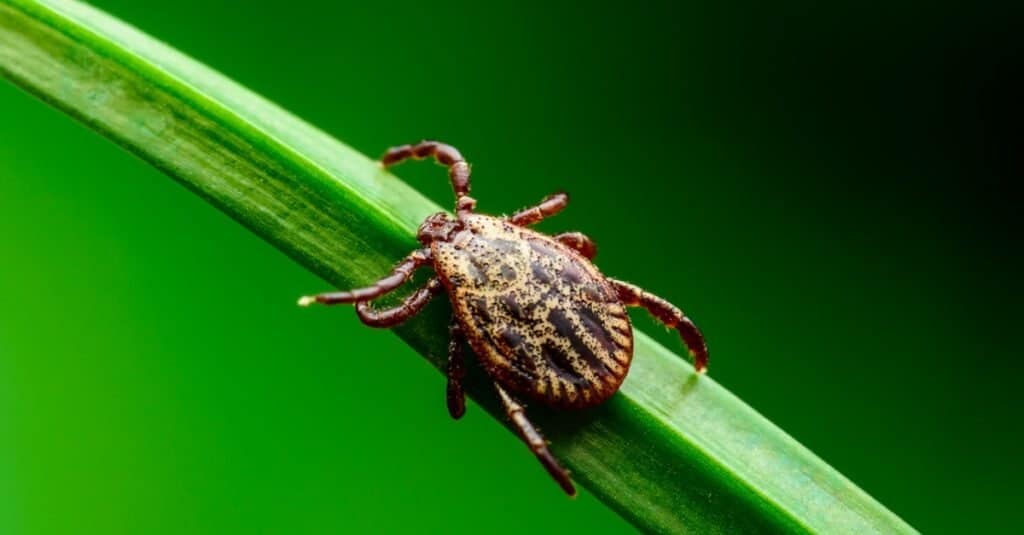
American dog ticks are the largest ticks in Wyoming.
©iStock.com/nechaev-kon
The largest ticks in Wyoming are American dog ticks. They look similar to Rocky Mountain wood ticks and transmit some of the same diseases. American dog ticks are the primary vector for Rocky Mountain spotted fever. They’re prey generalists who take blood from anything that moves, including mice, rats, squirrels, foxes, deer, horses, elk, humans, and dogs.
Both male and female American dog ticks have brown legs, brown bodies, and small mouthparts. Males have allover tan and brown mottled bodies, and females have tan scuta and brown bodies.
Rabbit Tick
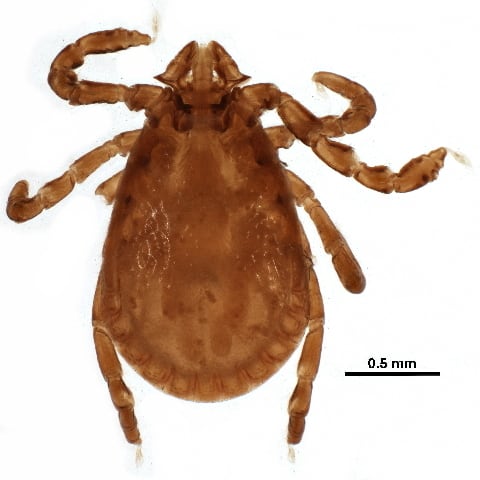
Rabbit ticks get their name from their preferred host.
©CBG Photography Group, Centre for Biodiversity Genomics / Creative Commons – License
These ticks in Wyoming are very small and prey mainly on small mammals. As you might have guessed from their name, their favorite blood comes from hares and rabbits. They’ll also bite woodchucks, prairie dogs, badgers, and foxes. Rabbit ticks don’t bite humans and aren’t known to transmit diseases. They’re small and medium brown and can often be seen on rabbit’s ears.
Groundhog Tick

Groundhog ticks find a home around animal dens.
©iStock.com/jonnysek
Also known as the woodchuck tick, these ticks prey primarily on groundhogs. They’re very small and rarely seen by humans. Both males and females are light brown. Groundhog ticks in Wyoming feed on weasels, dogs, raccoons, foxes, woodchucks, skunks, and porcupines, among other species. They mostly live in or around animal dens and nests.
Deer Tick

Deer ticks go through four life stages: egg, larva, nymph, and adult.
©iStock.com/Ladislav Kubeš
Commonly known as blacklegged ticks, the deer ticks in Wyoming are few and far between. This species is much more common in neighboring Colorado, though they’re not unheard of in Wyoming. Deer ticks are the only type of tick capable of transmitting Lyme disease. Females are easily identifiable by their very large mouthparts, black scuta, and black legs. Males are smaller, with dark brown to black bodies and legs.
Deer ticks feed primarily on white-tailed deer but won’t hesitate to bite humans or dogs that come too close. They’re very prevalent in the northeastern United States.
Winter Tick
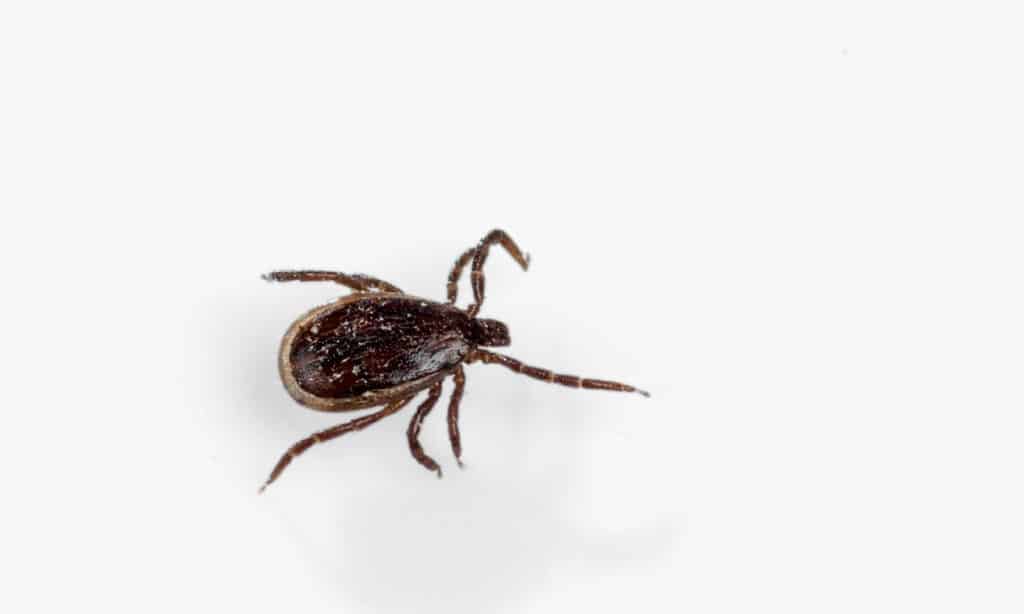
Winter ticks get their name from their most active time of year.
©iStock.com/VladK213
These ticks in Wyoming are confined to large game animals, like moose, elk, and bear. They almost never bite humans and aren’t known to carry any diseases or infections. These ticks become active in fall and winter when other tick species go into brumation. Winter ticks spend their entire lives on a single host.
Brown Dog Tick
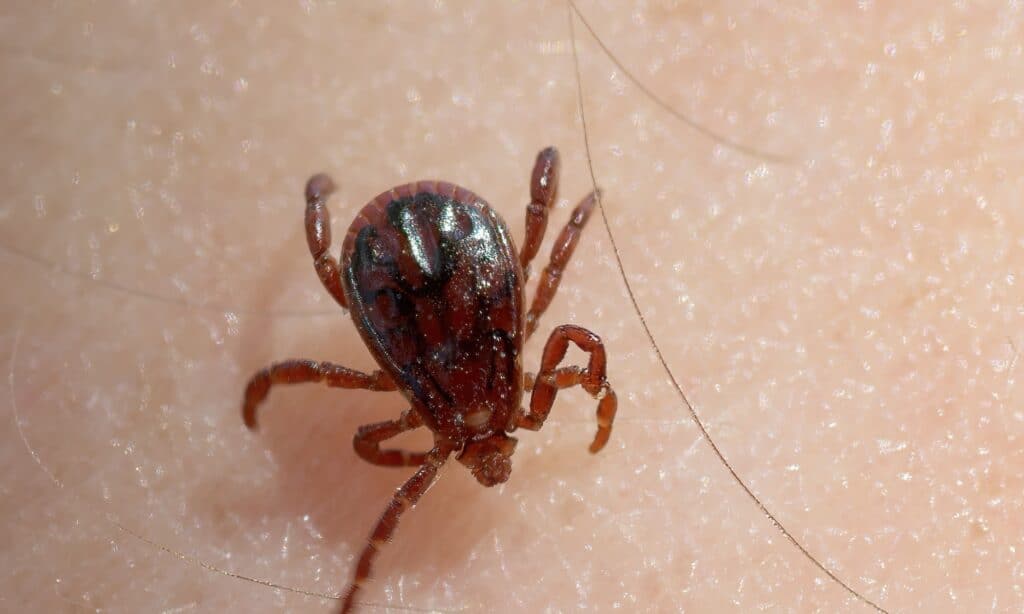
Most ticks live outdoors, but not brown dog ticks.
©iStock.com/RobertAx
Brown dog ticks are unique among ticks in Wyoming that live indoors rather than in nature. These ticks live exclusively near dogs, either in veterinary clinics, animal shelters, boarding facilities, or private homes. They do not carry Lyme disease but do carry canine-specific diseases. If you find a brown dog tick embedded on your dog, remove it immediately, and sterilize the bite area.
Do Ticks in Wyoming have Lyme Disease?
Fortunately, there are few deer ticks in Wyoming, which means Lyme disease is rare. If you suspect that you’ve been bitten by a deer tick, seek medical immediate medical advice.
How to Avoid Ticks in Wyoming
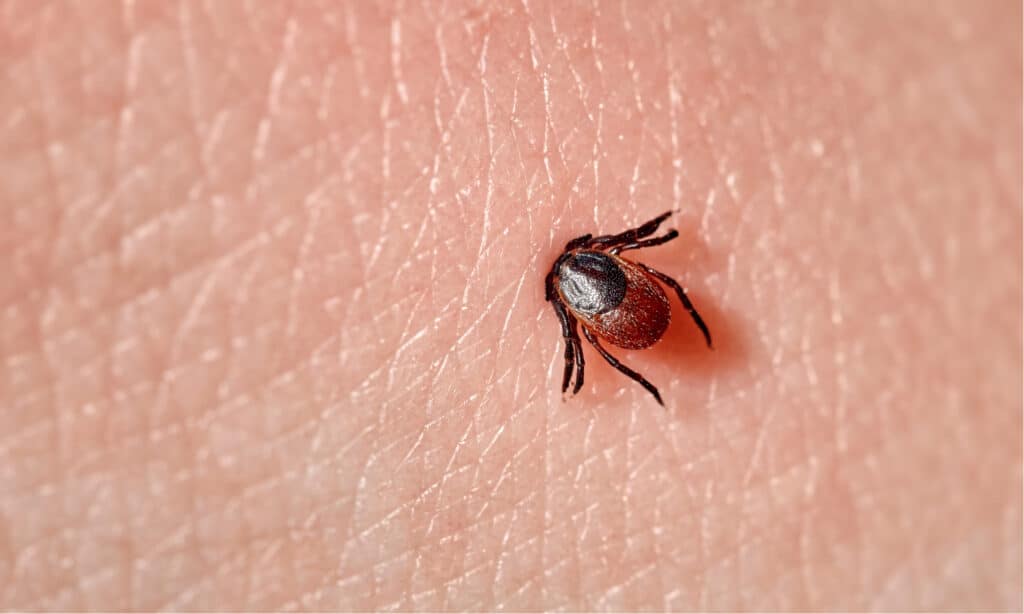
One of the best ways to prevent a tick bite is by keeping them off your skin.
©Evgeniyqw/Shutterstock.com
There are three steps to avoiding ticks in Wyoming. First, wear light-colored clothing that covers as much of your body as possible. Then, spray your clothes and shoes (never your skin) with insect repellent. Then, stay out of any foliage that brushes against your clothes. Ticks can’t jump, so brushing up against grass or underbrush creates a highway for them to climb onto your skin.
If you’re in a particularly tick-heavy area and you can’t avoid brushing up against foliage, there are additional steps you can take. These include tucking your pants into your socks, tucking your shirt into your pants, and wearing gloves. Finally, after any outdoor activity, be sure to perform a thorough self-check for ticks.
The photo featured at the top of this post is © 7th Son Studio/Shutterstock.com
Thank you for reading! Have some feedback for us? Contact the AZ Animals editorial team.







